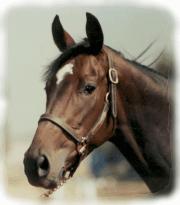A Horse, of Course with Don Blazer |
If you enjoy learning about horses, then you'll love our online courses. Each month you'll find a new column on our web site. We hope you'll enjoy it, and maybe e-mail us with questions or suggestions for other columns. A Horse, Of Course is a monthly column syndicated by Success Is Easy. If you like the column, call your local newspaper, or local horse publication and ask them to subscribe by contacting Success Is Easy. |
Horse Cues - Apply and Release Don Blazer copyright©2010 There are two sides to everything. Two sides to a coin, for up there’s down, for in, there’s out, for yin, there’s yang. Most would say that they don’t like a “quitter.” But quitting is just the other side of persisting. When training horses, knowing when to quit is just as important as knowing when to persist. Horses don’t learn from the cue (persistence of stimulus), they learn from the discontinuance of the stimulus (quit). For example, you ask a horse to walk by applying slight leg pressure which stimulates a response from the central nervous system and the horse moves forward. When the horse moves forward you discontinue the leg pressure as a reward for the horse’s response. Do this enough times and the horse figures out if he moves forward the pressure will go away…soon his response to the light leg pressure becomes a habit, and the horse is, so to speak, trained. If you did not release the cue, the horse would be put into what “behaviorists” call “learned helplessness”. The pressure is continuous, so the horse has no idea what he did, didn’t do, or what to do to escape the pressure. Application of a cue is one side; the other side is the release of a cue…quitting instead of persisting. Almost anyone handling horses knows how to apply a cue to get a response---that doesn’t mean they know the correct cue for a specific response, but they know how to apply some kind of pressure. Knowing the correct cue for a specific result is what makes a good trainer. Knowing when to quit a cue is what makes a good trainer a better trainer. There are two other times to quit that good trainers know. Once a horse is making just the slightest bit of progress in learning the lesson you are teaching, it is time to quit. Working a horse at the same exercise again and again and again doesn’t make a horse better; it makes the horse resent his work and dull to the request. Instead of attempting to give you the correct response, the horse may seek a new way of escaping the cue (pressure). Getting an improved response to your cue, then asking again and then again, happens frequently when a horse is a “natural” and progressing rapidly. Instead of being satisfied with a small improvement the trainer thinks this special horse can learn it all in one session. The horse gives an improved response and the trainer says, “just one time.” Except they never leave it at one more time…it’s time and time and time again. Learn to quit. It’s time to quit when the horse you’re training isn’t showing marked improvement in gait, understanding or proficiency at an event. Too often owners and trainers are determined to make a horse into something he or she isn’t. They persist and persist and the horse who has reached his potential simply levels off, then becomes resentful, and finally becomes a problem horse. If the horse doesn’t have the athletic ability to perform at the level you desire….quit. Conditioning is a good thing, but you can’t train something into a horse that the horse doesn’t have naturally. If the horse isn’t a natural western pleasure horse, or hunt seat horse, or reiner….quit! Find a new job for that horse. Yes, sell the horse and get a horse that can work to your level of expectation. Being a “quitter” isn’t a bad thing if “quitting” actually benefits the horse. Quitting can open the door to new opportunities….especially if you’re persistent. Visit A Horse, Of Course on the Internet at www.donblazer.com |
